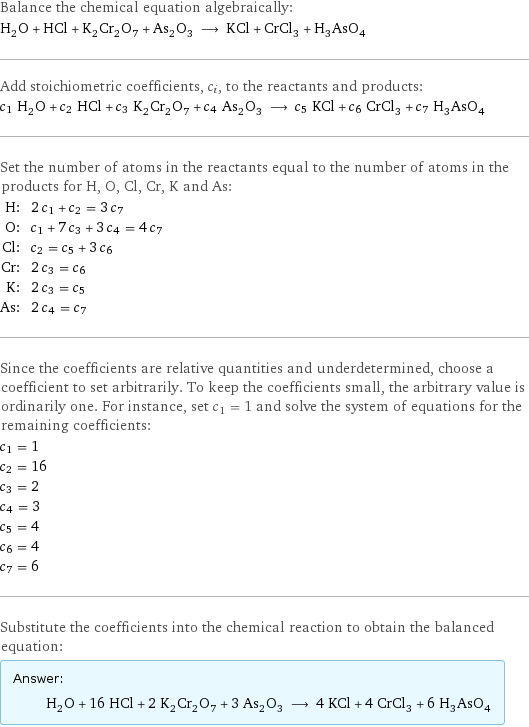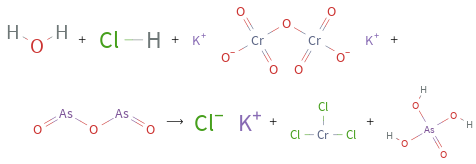Input interpretation

H_2O water + HCl hydrogen chloride + K_2Cr_2O_7 potassium dichromate + As_2O_3 arsenic trioxide ⟶ KCl potassium chloride + CrCl_3 chromic chloride + H_3AsO_4 arsenic acid, solid
Balanced equation

Balance the chemical equation algebraically: H_2O + HCl + K_2Cr_2O_7 + As_2O_3 ⟶ KCl + CrCl_3 + H_3AsO_4 Add stoichiometric coefficients, c_i, to the reactants and products: c_1 H_2O + c_2 HCl + c_3 K_2Cr_2O_7 + c_4 As_2O_3 ⟶ c_5 KCl + c_6 CrCl_3 + c_7 H_3AsO_4 Set the number of atoms in the reactants equal to the number of atoms in the products for H, O, Cl, Cr, K and As: H: | 2 c_1 + c_2 = 3 c_7 O: | c_1 + 7 c_3 + 3 c_4 = 4 c_7 Cl: | c_2 = c_5 + 3 c_6 Cr: | 2 c_3 = c_6 K: | 2 c_3 = c_5 As: | 2 c_4 = c_7 Since the coefficients are relative quantities and underdetermined, choose a coefficient to set arbitrarily. To keep the coefficients small, the arbitrary value is ordinarily one. For instance, set c_1 = 1 and solve the system of equations for the remaining coefficients: c_1 = 1 c_2 = 16 c_3 = 2 c_4 = 3 c_5 = 4 c_6 = 4 c_7 = 6 Substitute the coefficients into the chemical reaction to obtain the balanced equation: Answer: | | H_2O + 16 HCl + 2 K_2Cr_2O_7 + 3 As_2O_3 ⟶ 4 KCl + 4 CrCl_3 + 6 H_3AsO_4
Structures

+ + + ⟶ + +
Names

water + hydrogen chloride + potassium dichromate + arsenic trioxide ⟶ potassium chloride + chromic chloride + arsenic acid, solid
Equilibrium constant
![Construct the equilibrium constant, K, expression for: H_2O + HCl + K_2Cr_2O_7 + As_2O_3 ⟶ KCl + CrCl_3 + H_3AsO_4 Plan: • Balance the chemical equation. • Determine the stoichiometric numbers. • Assemble the activity expression for each chemical species. • Use the activity expressions to build the equilibrium constant expression. Write the balanced chemical equation: H_2O + 16 HCl + 2 K_2Cr_2O_7 + 3 As_2O_3 ⟶ 4 KCl + 4 CrCl_3 + 6 H_3AsO_4 Assign stoichiometric numbers, ν_i, using the stoichiometric coefficients, c_i, from the balanced chemical equation in the following manner: ν_i = -c_i for reactants and ν_i = c_i for products: chemical species | c_i | ν_i H_2O | 1 | -1 HCl | 16 | -16 K_2Cr_2O_7 | 2 | -2 As_2O_3 | 3 | -3 KCl | 4 | 4 CrCl_3 | 4 | 4 H_3AsO_4 | 6 | 6 Assemble the activity expressions accounting for the state of matter and ν_i: chemical species | c_i | ν_i | activity expression H_2O | 1 | -1 | ([H2O])^(-1) HCl | 16 | -16 | ([HCl])^(-16) K_2Cr_2O_7 | 2 | -2 | ([K2Cr2O7])^(-2) As_2O_3 | 3 | -3 | ([As2O3])^(-3) KCl | 4 | 4 | ([KCl])^4 CrCl_3 | 4 | 4 | ([CrCl3])^4 H_3AsO_4 | 6 | 6 | ([H3AsO4])^6 The equilibrium constant symbol in the concentration basis is: K_c Mulitply the activity expressions to arrive at the K_c expression: Answer: | | K_c = ([H2O])^(-1) ([HCl])^(-16) ([K2Cr2O7])^(-2) ([As2O3])^(-3) ([KCl])^4 ([CrCl3])^4 ([H3AsO4])^6 = (([KCl])^4 ([CrCl3])^4 ([H3AsO4])^6)/([H2O] ([HCl])^16 ([K2Cr2O7])^2 ([As2O3])^3)](../image_source/7d2781c633af7545880e6cdba8a9b50b.png)
Construct the equilibrium constant, K, expression for: H_2O + HCl + K_2Cr_2O_7 + As_2O_3 ⟶ KCl + CrCl_3 + H_3AsO_4 Plan: • Balance the chemical equation. • Determine the stoichiometric numbers. • Assemble the activity expression for each chemical species. • Use the activity expressions to build the equilibrium constant expression. Write the balanced chemical equation: H_2O + 16 HCl + 2 K_2Cr_2O_7 + 3 As_2O_3 ⟶ 4 KCl + 4 CrCl_3 + 6 H_3AsO_4 Assign stoichiometric numbers, ν_i, using the stoichiometric coefficients, c_i, from the balanced chemical equation in the following manner: ν_i = -c_i for reactants and ν_i = c_i for products: chemical species | c_i | ν_i H_2O | 1 | -1 HCl | 16 | -16 K_2Cr_2O_7 | 2 | -2 As_2O_3 | 3 | -3 KCl | 4 | 4 CrCl_3 | 4 | 4 H_3AsO_4 | 6 | 6 Assemble the activity expressions accounting for the state of matter and ν_i: chemical species | c_i | ν_i | activity expression H_2O | 1 | -1 | ([H2O])^(-1) HCl | 16 | -16 | ([HCl])^(-16) K_2Cr_2O_7 | 2 | -2 | ([K2Cr2O7])^(-2) As_2O_3 | 3 | -3 | ([As2O3])^(-3) KCl | 4 | 4 | ([KCl])^4 CrCl_3 | 4 | 4 | ([CrCl3])^4 H_3AsO_4 | 6 | 6 | ([H3AsO4])^6 The equilibrium constant symbol in the concentration basis is: K_c Mulitply the activity expressions to arrive at the K_c expression: Answer: | | K_c = ([H2O])^(-1) ([HCl])^(-16) ([K2Cr2O7])^(-2) ([As2O3])^(-3) ([KCl])^4 ([CrCl3])^4 ([H3AsO4])^6 = (([KCl])^4 ([CrCl3])^4 ([H3AsO4])^6)/([H2O] ([HCl])^16 ([K2Cr2O7])^2 ([As2O3])^3)
Rate of reaction
![Construct the rate of reaction expression for: H_2O + HCl + K_2Cr_2O_7 + As_2O_3 ⟶ KCl + CrCl_3 + H_3AsO_4 Plan: • Balance the chemical equation. • Determine the stoichiometric numbers. • Assemble the rate term for each chemical species. • Write the rate of reaction expression. Write the balanced chemical equation: H_2O + 16 HCl + 2 K_2Cr_2O_7 + 3 As_2O_3 ⟶ 4 KCl + 4 CrCl_3 + 6 H_3AsO_4 Assign stoichiometric numbers, ν_i, using the stoichiometric coefficients, c_i, from the balanced chemical equation in the following manner: ν_i = -c_i for reactants and ν_i = c_i for products: chemical species | c_i | ν_i H_2O | 1 | -1 HCl | 16 | -16 K_2Cr_2O_7 | 2 | -2 As_2O_3 | 3 | -3 KCl | 4 | 4 CrCl_3 | 4 | 4 H_3AsO_4 | 6 | 6 The rate term for each chemical species, B_i, is 1/ν_i(Δ[B_i])/(Δt) where [B_i] is the amount concentration and t is time: chemical species | c_i | ν_i | rate term H_2O | 1 | -1 | -(Δ[H2O])/(Δt) HCl | 16 | -16 | -1/16 (Δ[HCl])/(Δt) K_2Cr_2O_7 | 2 | -2 | -1/2 (Δ[K2Cr2O7])/(Δt) As_2O_3 | 3 | -3 | -1/3 (Δ[As2O3])/(Δt) KCl | 4 | 4 | 1/4 (Δ[KCl])/(Δt) CrCl_3 | 4 | 4 | 1/4 (Δ[CrCl3])/(Δt) H_3AsO_4 | 6 | 6 | 1/6 (Δ[H3AsO4])/(Δt) (for infinitesimal rate of change, replace Δ with d) Set the rate terms equal to each other to arrive at the rate expression: Answer: | | rate = -(Δ[H2O])/(Δt) = -1/16 (Δ[HCl])/(Δt) = -1/2 (Δ[K2Cr2O7])/(Δt) = -1/3 (Δ[As2O3])/(Δt) = 1/4 (Δ[KCl])/(Δt) = 1/4 (Δ[CrCl3])/(Δt) = 1/6 (Δ[H3AsO4])/(Δt) (assuming constant volume and no accumulation of intermediates or side products)](../image_source/9a3760bf448290afb466f5f17ed63019.png)
Construct the rate of reaction expression for: H_2O + HCl + K_2Cr_2O_7 + As_2O_3 ⟶ KCl + CrCl_3 + H_3AsO_4 Plan: • Balance the chemical equation. • Determine the stoichiometric numbers. • Assemble the rate term for each chemical species. • Write the rate of reaction expression. Write the balanced chemical equation: H_2O + 16 HCl + 2 K_2Cr_2O_7 + 3 As_2O_3 ⟶ 4 KCl + 4 CrCl_3 + 6 H_3AsO_4 Assign stoichiometric numbers, ν_i, using the stoichiometric coefficients, c_i, from the balanced chemical equation in the following manner: ν_i = -c_i for reactants and ν_i = c_i for products: chemical species | c_i | ν_i H_2O | 1 | -1 HCl | 16 | -16 K_2Cr_2O_7 | 2 | -2 As_2O_3 | 3 | -3 KCl | 4 | 4 CrCl_3 | 4 | 4 H_3AsO_4 | 6 | 6 The rate term for each chemical species, B_i, is 1/ν_i(Δ[B_i])/(Δt) where [B_i] is the amount concentration and t is time: chemical species | c_i | ν_i | rate term H_2O | 1 | -1 | -(Δ[H2O])/(Δt) HCl | 16 | -16 | -1/16 (Δ[HCl])/(Δt) K_2Cr_2O_7 | 2 | -2 | -1/2 (Δ[K2Cr2O7])/(Δt) As_2O_3 | 3 | -3 | -1/3 (Δ[As2O3])/(Δt) KCl | 4 | 4 | 1/4 (Δ[KCl])/(Δt) CrCl_3 | 4 | 4 | 1/4 (Δ[CrCl3])/(Δt) H_3AsO_4 | 6 | 6 | 1/6 (Δ[H3AsO4])/(Δt) (for infinitesimal rate of change, replace Δ with d) Set the rate terms equal to each other to arrive at the rate expression: Answer: | | rate = -(Δ[H2O])/(Δt) = -1/16 (Δ[HCl])/(Δt) = -1/2 (Δ[K2Cr2O7])/(Δt) = -1/3 (Δ[As2O3])/(Δt) = 1/4 (Δ[KCl])/(Δt) = 1/4 (Δ[CrCl3])/(Δt) = 1/6 (Δ[H3AsO4])/(Δt) (assuming constant volume and no accumulation of intermediates or side products)
Chemical names and formulas
![| water | hydrogen chloride | potassium dichromate | arsenic trioxide | potassium chloride | chromic chloride | arsenic acid, solid formula | H_2O | HCl | K_2Cr_2O_7 | As_2O_3 | KCl | CrCl_3 | H_3AsO_4 Hill formula | H_2O | ClH | Cr_2K_2O_7 | As_2O_3 | ClK | Cl_3Cr | AsH_3O_4 name | water | hydrogen chloride | potassium dichromate | arsenic trioxide | potassium chloride | chromic chloride | arsenic acid, solid IUPAC name | water | hydrogen chloride | dipotassium oxido-(oxido-dioxochromio)oxy-dioxochromium | 2, 4, 5-trioxa-1, 3-diarsabicyclo[1.1.1]pentane | potassium chloride | trichlorochromium | arsoric acid](../image_source/6083983a4fd2fec69c21294d7e3dd962.png)
| water | hydrogen chloride | potassium dichromate | arsenic trioxide | potassium chloride | chromic chloride | arsenic acid, solid formula | H_2O | HCl | K_2Cr_2O_7 | As_2O_3 | KCl | CrCl_3 | H_3AsO_4 Hill formula | H_2O | ClH | Cr_2K_2O_7 | As_2O_3 | ClK | Cl_3Cr | AsH_3O_4 name | water | hydrogen chloride | potassium dichromate | arsenic trioxide | potassium chloride | chromic chloride | arsenic acid, solid IUPAC name | water | hydrogen chloride | dipotassium oxido-(oxido-dioxochromio)oxy-dioxochromium | 2, 4, 5-trioxa-1, 3-diarsabicyclo[1.1.1]pentane | potassium chloride | trichlorochromium | arsoric acid
Substance properties

| water | hydrogen chloride | potassium dichromate | arsenic trioxide | potassium chloride | chromic chloride | arsenic acid, solid molar mass | 18.015 g/mol | 36.46 g/mol | 294.18 g/mol | 197.84 g/mol | 74.55 g/mol | 158.3 g/mol | 141.94 g/mol phase | liquid (at STP) | gas (at STP) | solid (at STP) | solid (at STP) | solid (at STP) | solid (at STP) | solid (at STP) melting point | 0 °C | -114.17 °C | 398 °C | 312 °C | 770 °C | 1152 °C | 35.5 °C boiling point | 99.9839 °C | -85 °C | | 465 °C | 1420 °C | | 160 °C density | 1 g/cm^3 | 0.00149 g/cm^3 (at 25 °C) | 2.67 g/cm^3 | 4.15 g/cm^3 | 1.98 g/cm^3 | 2.87 g/cm^3 | 2.2 g/cm^3 solubility in water | | miscible | | | soluble | slightly soluble | surface tension | 0.0728 N/m | | | | | | dynamic viscosity | 8.9×10^-4 Pa s (at 25 °C) | | | | | | odor | odorless | | odorless | | odorless | |
Units
